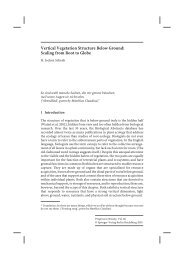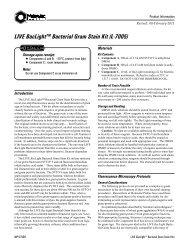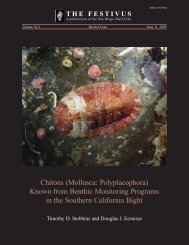Landscape Evolution at an Active Plate Margin - Biological Science ...
Landscape Evolution at an Active Plate Margin - Biological Science ...
Landscape Evolution at an Active Plate Margin - Biological Science ...
You also want an ePaper? Increase the reach of your titles
YUMPU automatically turns print PDFs into web optimized ePapers that Google loves.
D. R. Jessey <strong>an</strong>d R. E. Reynolds<br />
Figure 3-8. Salt tram; found<strong>at</strong>ions in foreground; pylon on horizon. [R. E. Reynolds photo]<br />
to the Cottonwood kilns to get more charcoal. When<br />
the Molly Stevens burned, the Bessy Brady steam<br />
paddle-wheeler continued running silver ingots from<br />
Keeler <strong>an</strong>d Sw<strong>an</strong>sea to Cartago (Day 1, MP-127.7).<br />
The smelter produced silver ingots faster th<strong>an</strong> Remi<br />
Nedeau’s nine mule teams could carry them on the<br />
route to Mojave. By 1873, over 30,000 ingots were<br />
stockpiled. Enterprising miners stacked the ingots,<br />
stretched c<strong>an</strong>vas over them, <strong>an</strong>d lived in shelters<br />
made of silver bars (Millspaugh, 1971). PROCEED<br />
SOUTH toward Keeler.<br />
81.6 (1.5) PULL RIGHT <strong>an</strong>d PARK <strong>at</strong> Owens Lake<br />
Desicc<strong>at</strong>ion Monument.<br />
STOP 3-8. Owens Lake to the south has been the<br />
southern terminus for the Owens River for the last<br />
800,000 years (Smith et al., 1993). Owens Lake surface<br />
w<strong>at</strong>er has been claimed <strong>an</strong>d diverted for hum<strong>an</strong><br />
use. Ground w<strong>at</strong>er is now tapped for the w<strong>at</strong>er supply.<br />
Arid-l<strong>an</strong>d surfaces th<strong>at</strong> were previously stabilized by<br />
veget<strong>at</strong>ion are increasingly susceptible to wind erosion,<br />
causing defl<strong>at</strong>ion <strong>an</strong>d dust storms. Since desicc<strong>at</strong>ion,<br />
wind-blown dust <strong>an</strong>d salt have cre<strong>at</strong>ed visibility<br />
problems for residents of Owens Valley <strong>an</strong>d military<br />
research <strong>at</strong> China Lake in Indi<strong>an</strong> Wells Valley (Reheis,<br />
in press).<br />
During the early 1900s the lake fluctu<strong>at</strong>ed<br />
between about 20–45 feet deep <strong>an</strong>d had <strong>an</strong><br />
area of about 174 sq miles (280 km 2) . W<strong>at</strong>er<br />
was first diverted from the Owens River<br />
to the City of Los Angeles in 1913, <strong>an</strong>d by<br />
1926 Owens Lake was dry.<br />
The dry bed of Owens Lake<br />
has produced enormous<br />
amounts of windblown dust<br />
since the desicc<strong>at</strong>ion of the<br />
lake. The lake bed is probably<br />
the largest single source<br />
of dust (aerosol particles<br />
smaller th<strong>an</strong> 10 microns)<br />
in the United St<strong>at</strong>es, by one<br />
estim<strong>at</strong>e, 900,000–8,000,000<br />
metric tons per year (Gill<br />
<strong>an</strong>d Gillette, 1991). Assuming<br />
a lake-bed area of 280<br />
km 2 <strong>an</strong>d a density of 1.5-2.0<br />
g/cm 3 for lake sediment,<br />
erosion of this amount of<br />
dust would lower the lake<br />
bed by 0.2-–1.5 centimeters<br />
per year. Micron-size dust<br />
is regul<strong>at</strong>ed by California<br />
<strong>an</strong>d United St<strong>at</strong>es agencies because dust<br />
particles are so small they c<strong>an</strong> be inhaled<br />
into the hum<strong>an</strong> respir<strong>at</strong>ory system to cre<strong>at</strong>e<br />
health hazards. “One day [in 1995] in<br />
Keeler, particles surged to a n<strong>at</strong>ionwide<br />
record th<strong>at</strong> was 23 times gre<strong>at</strong>er th<strong>an</strong><br />
a federal health st<strong>an</strong>dard allows” (Los<br />
Angeles Times, 12/17/96). Keeler residents<br />
are exposed to unhealthful levels 25 days<br />
a year. Th<strong>at</strong> situ<strong>at</strong>ion occurs in Ridgecrest<br />
10 days a year (Gre<strong>at</strong> Basin air agency).<br />
“When we see the white cloud headed<br />
through the pass, the ER <strong>an</strong>d doctors’ offices<br />
fill up with people. It’s straightforward<br />
cause <strong>an</strong>d effect” (Dr. Bruce Parker, physici<strong>an</strong><br />
<strong>at</strong> Ridgecrest Community Hospital).<br />
An additional health concern is inhal<strong>at</strong>ion<br />
of trace metals in dust from the lake bed<br />
Table 3-2. Fossil faunas, Owens Lake playa.<br />
Common Name Generic Name<br />
Bony fish Osteichthyes<br />
Minnow Siph<strong>at</strong>eles bicolor snyderi (Miller)<br />
Owens sucker C<strong>at</strong>ostomus fumeiventris Miller*<br />
Lesser scaup Athya affinis<br />
Meadowlark Sturnella neglecta<br />
Botta’s gopher Thomomys bottae<br />
Wolf C<strong>an</strong>is lupus**<br />
Lion (medium-size) Felidae<br />
Antelope Antilocapra sp. **<br />
Horse Equus sp.<br />
Large camel Camelops sp.<br />
Bison Bison sp.<br />
Eleph<strong>an</strong>t Proboscidea<br />
(* Gerald R. Smith, p. c. to Reynolds, 3/09;<br />
** R. Serr<strong>an</strong>o, C. Shaw, p. c. to Reynolds, 3/09)<br />
50 2009 Desert Symposium
















